|
Me Sahyadri - Forgotten Caves |
|
January 2015 |
|
Volume 2, number 1 |
|
Please use minimum 1280 pixel horizontal screen
resolution for viewing. Please be patient while all the images in
webpage are loaded. Please do not use the images for any commercial
use without permission. Text in Marathi and English is not exact
translation. Special thanks to all those who helped me during the compilation and field work for the help and guidance. |
|
Warning : The location photographed in this journal is in wilderness. The location is habitat of Honey Bees and Leopards. Please do not venture to the location without professional approach and local support. Honeybees are likely to attack all the visitors. There have been fatal honey bee attacks in the caves around Junnar including these caves. completely covered dress with net around the head is necessary. या लेण्यांमध्ये आग्या मधमाश्यांची पोळी आहेत. यामुळे येथे जाणे अत्यंत धोकादायक आहे. गावापासुन दुर दुर्गम ठिकाणी असलेल्या या लेण्यांमध्ये व अशा जुन्नर जवळच्या इतर लेण्यांमध्ये मधमाश्या चावल्यामुळे अपघात व मृत्यु झाल्याच्या बऱ्याच घटना घडल्या आहेत. स्थानिक वाटाड़्या, व मधमाश्यांपासुन बचाव करता येईल असा बंदिस्त वेश (पुर्ण बंदिस्त जाळीदार टोपीसहित) असल्याशिवाय येथे जाणे टाळावे. |
|
|
|
|
सह्याद्री (पश्चिम घाट) हा एक नैसर्गिक संपदेचा, वैविध्यतेचा, भौगोलिक व ऐतिहासिक ठेवा आहे. वाढत्या मानवी अतिक्रमणाचा, सह्याद्रीच्या विविध घटकांवर होणारा दुष्परिणाम भविष्यात आपल्यालाच धोका निर्माण करेल, यात शंका नाही. शुद्ध पाणी, हवा व उर्जा, भावी पिढीला मिळण्यासाठी, नंद्यांचे उगम असलेला सह्याद्री व त्याभागातील जंगले टिकवणे महत्वाचे आहे. सह्याद्रीच्या महत्वाच्या घटकांचे महत्व छायाचित्रांद्वारे प्रकट करण्याचा मी येथे प्रयत्न केला आहे. येथील पक्षी, प्राणी, वनस्पती, अधिवास, किल्ले व लेणी अशा विविध विषयांबद्दल आपण समजुन घेऊ.
|
|
Western ghats, or Sahyadri as we all call it as, is a treasure trove of spectacular landscapes, biodiversity, flora, fauna, some amazing geological wonders and man made monuments. With the increasing pressure from human encroachment, all these elements are under stress and in turn are under depletion. Western ghats should be left untouched by human beings, to protect their future generations from getting short of resources, such as water, energy and clean air. The important elements of western ghats, which need protection are highlighted in the new version of Photo journal , Me Sahyadri Magazine. The current issue has a brief of inspiring subjects such as birds, mammals, forts, ancient caves, snakes and the ambiance.
|
|
|
| |
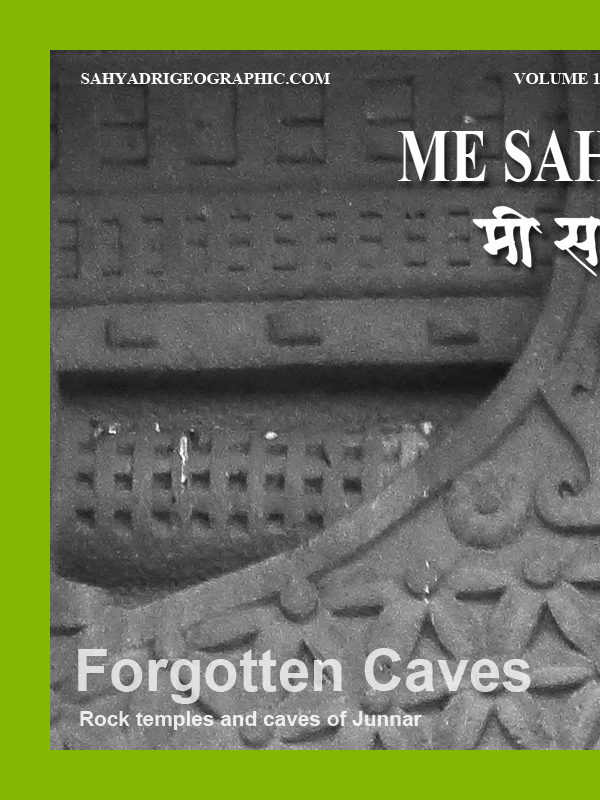  |
| |
| Me Sahyadri – January 2015 - Forgotten Caves - Caves of Junnar
|
| |
|
|
Junnar is the principal town of the northernmost taluka of Pune district, and is at a distance of about 90 km by road. The name “Junnar” is said to be a corruption of Junaa nagara "the ancient city." The town has traces of ancient Hindu, Buddhist, and Jain civilizations.
|
|
जुन्नर शहर हे अतिप्राचिन शहर आहे. जुन्नानगर असा याचा उल्लेख आढळतो. धार्मिक, आर्थिक व राजकिय दृष्ट्या जुन्नर हे महत्वाचे ठाणे होते. जुन्नर प्राचिन महाराष्ट्राची राजधानी होती. हिन्दु, बुद्ध, जैन, प्रणालींशी निगडीत विविध प्राचीन कालिन संदर्भ व पुरातन अवशेष जुन्नर भोवती आढळतात.
|
|
|
| |
 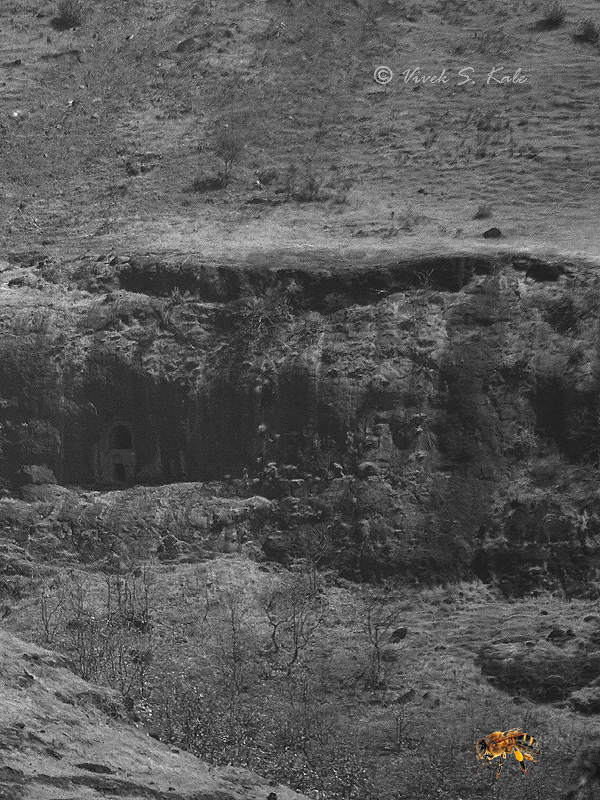 |
| |
| Forgotten Buddhist Caves, Pune district, Western ghats, India
|
| |
|
|
Junnar is located on the deccan plateau, 20 km east of the main western ghat ridge. The town is surrounded by hills from all the sides. There are mountain forts and old rock cut caves all around the Junnar town.
|
|
जुन्न्नरच्या भोवताली डोंगर आहेत. या डोंगरात प्राचिन बुद्ध हिनायन लेणी आहेत. अंदाजे ५७ विविध ठिकाणी असलेल्या लेण्यांमध्ये महत्वाचे चैत्यगृह आहेत, विहार आहेत. या लेण्यांचा संबंध बुद्ध, हिंदु व जैन धर्मांशी आहे.
|
|
|
| |
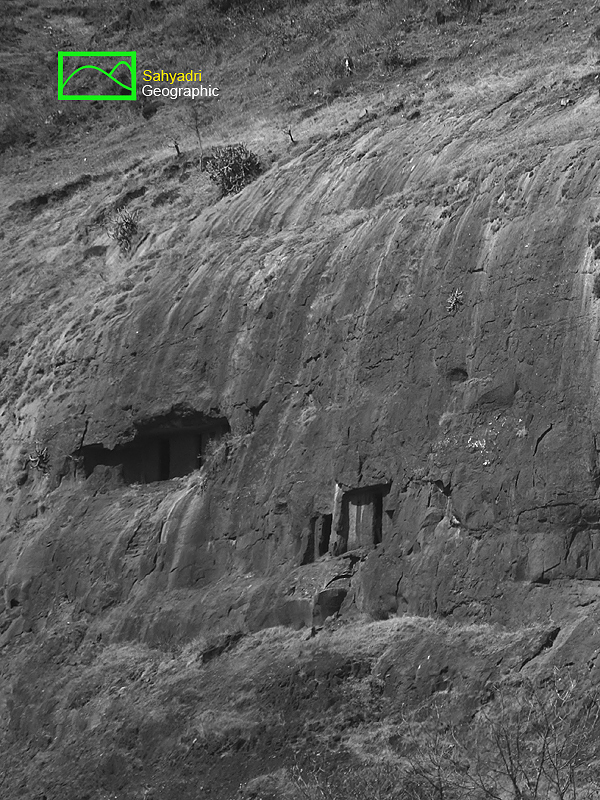 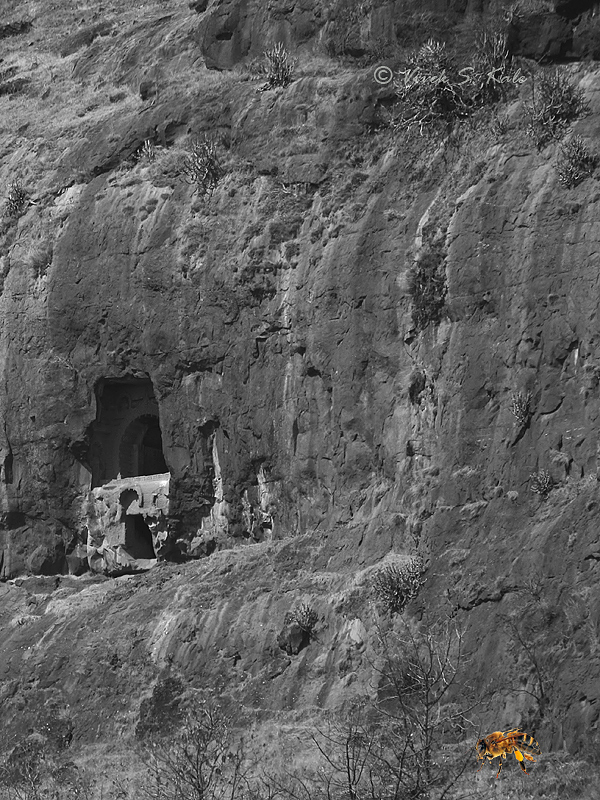 |
| |
| Forgotten Buddhist Caves near Junnar, Pune district, Western ghats, India
|
| |
|
|
As per the inscriptions at one of the caves at Maanmodi hills near Junnar the Indo-Scythia (Sakas) king Nahapahan had control over the area of Junnar and north western Maharashtra. There is a mention of The minister of the king donated for the religious acts at Bhimashankar caves of Junnar. Though the Indo-Scythia (western satraps) were different than the earlier Indo-greek empire of the north west India, they used Greek as their language. Later the Satwahan king Saatkarni defeated Nahapahan, to take the region under his control sometime in 78 CE.
|
|
पुर्व १५० ते इसविसन नंतर १५० वर्षे या कालावधित येथिल लेणी बनविल्या असाव्यात असे मानले जाते.
जुन्नरच्या लेण्यांमध्ये ३६ शिलालेख आहेत. मानमोडी लेण्यातील गिध लेण्यात (भीमाशंकर) लेण्यात एक महत्वाचा शिलालेख आहे. महाक्षपत्र नहपान याचा मंत्री अयम वत्सगोत्री याने धर्मकृत्य केले असा या लेखात उल्लेख आहे. नहापान राजाने भरुच वरुन येथे आक्रमण केले. त्याने पुणे, जुन्नर, नाशिक भागावर कब्जा केला. शक क्षत्रपाचे राज्य फार काळ टिकले नाही. गौतमीपुत्र सातकर्णी सातवाहनाने शक क्षत्रपाचा पराभव केला. लेण्यांव्यतिरिक्त येथे विविध गडकिल्ले आहेत.
|
|
|
| |
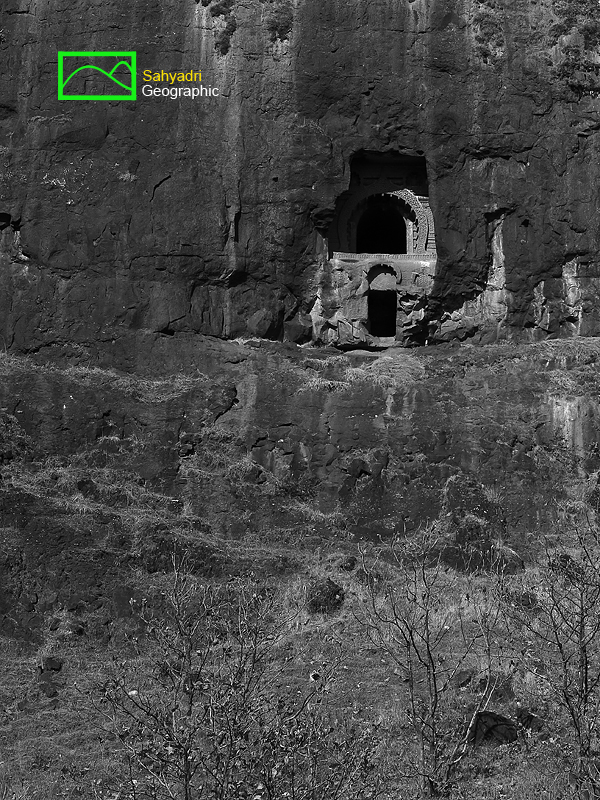 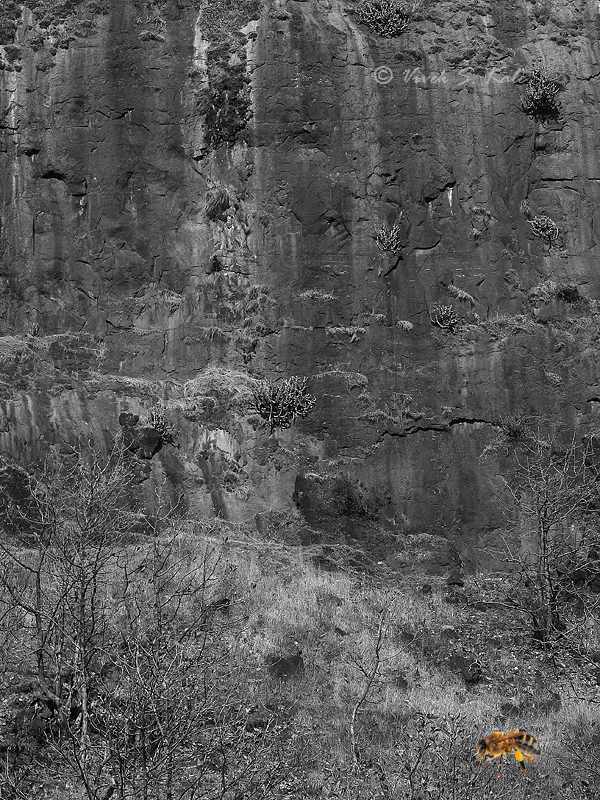 |
| |
| Forgotten Buddhist Caves near Junnar on cliff, Pune district, Western ghats, India
|
| |
|
|
As per British records there are rock cut caves at 57 separate locations. The five prominent caves identified by early British explorers such as James Fergusson, and James Burgess are, Shivneri cliff caves south west of Junnar, Tulaja Leni west of Junnar, Lenyadri leni (Ganesha caves) north of Junnar, East Ganesh hill caves north of Junnar, and the caves of Manmodi hill south of the town. There are total 10 Chaitya halls, 174 vihaars, 116 water tanks and 36 inscriptions in these caves. Shivneri caves have 3, Maanmodi caves have 3, Lenyadri caves have 2 and Tulajaa and Ganesh east caves have 1 each chaityagrihaa (Chaitya hall). Shivneri caves have 78, Maanmodi caves have 49, Lenyadri caves have 28 ,Tulajaa has 12 and Ganesh east caves have 7 vihaaras. Shivneri caves have 3, Maanmodi caves have 21 inscriptions. Shivneri caves have 60, Maanmodi caves have 38, Lenyadri caves have 15,Tulajaa have 2 and Ganesh east caves have 1 water tanks.
|
|
बिटिश लेखकांच्या मते जुन्नर भागात ५७ ठिकाणी लेणी आहेत. जुन्नर भोवताली असलेल्या महत्वाच्या ५ लेणी समुहात, नैऋत्येकडे शिवनेरी, पश्चिमेकडे तुळजा, दक्षिणेस मानमोडी, व उत्तरेकडे लेण्याद्री व सुलेमान लेणी आहेत. या सर्व लेण्यांमध्ये मिळुन १० चैत्यगृह, १७४ विहार, ११६ पाण्याची टाकी व ३६ शिलालेख आहेत. शिवनेरी लेणी येथे ३, लेण्याद्री येथे २, मानमोडी येथे ३, तुळजा येथे १ व गणेश पुर्व येथे १ चैत्यगृह आहेत. शिवनेरी लेणी येथे ७८, लेण्याद्री येथे २८, मानमोडी येथे ४९, तुळजा येथे १२ व गणेश पुर्व येथे ७ विहार आहेत. शिवनेरी लेणी येथे ३, लेण्याद्री येथे ६, मानमोडी येथे २१, शिलालेख आहेत. शिवनेरी लेणी येथे ६०, लेण्याद्री येथे १५, मानमोडी येथे ३८, तुळजा येथे २ व गणेश पुर्व येथे १ पाण्याची टाकी आहेत.
|
|
|
| |
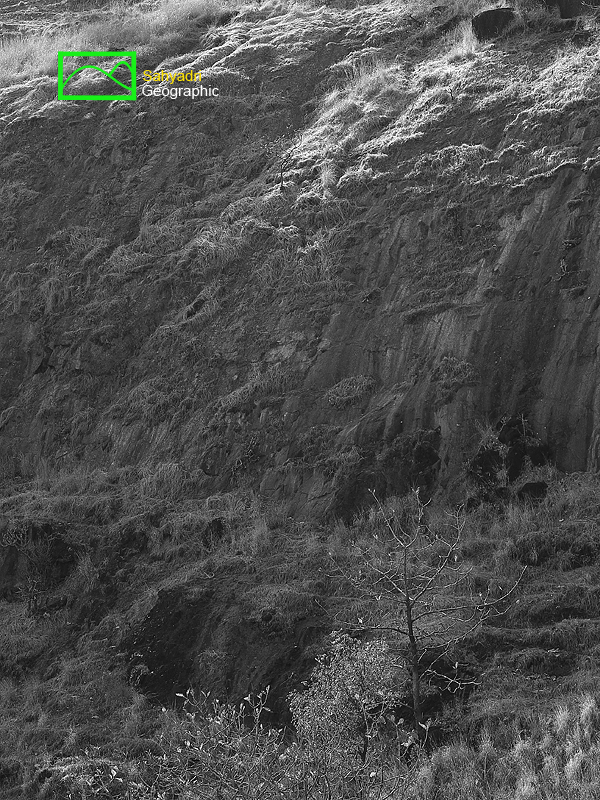 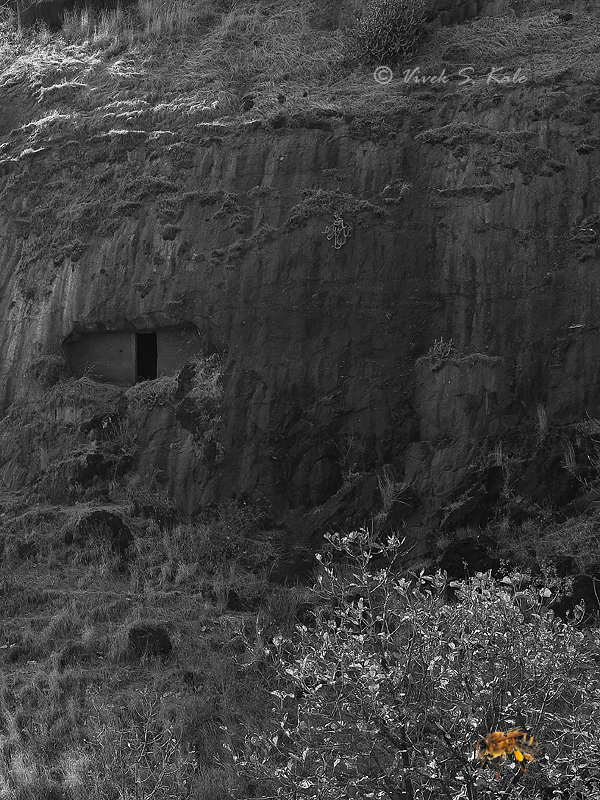 |
| |
| Forgotten Buddhist Caves near Junnar on cliff of Ganesh east hill, Pune district, Western ghats, India
|
| |
|
|
Most of the caves of Junnar are with very little ornamental and imagery carvings, in contrast with the caves of Verul and Ajantha. The Dagoba or the Stupaa is common in all the caves. Also none of the Junnar caves are as magnificent as caves of Karle, Bhaje or Nashik.
However the group comprises specimens of almost every variety of rock-cut temples, and several forms not found elsewhere. Though the caves of Junaar are plainer than most of those executed afterwards,are still not devoid of ornament. They form, in fact, an intermediate step between the puritanical plainness of the Kathiawar groups and those of the age that succeeded them. It is not easy to speak with any great precision with regard to the age of this group. They certainly, however, all belong to the first great division of Buddhist caves. The caves have been built between 150 B.C. and 150 A.D.
|
|
जुन्नर भोवतालची लेणी कार्ले, भाजे, बेडसे, नाशिकजवळच्या पांडव लेण्यांच्या तुलनेने कलेच्या व वैभवाच्या दृष्टीने कमी दर्जाची आहेत. मात्र लेण्यांच्या स्थापत्यशास्त्राच्या दृष्टीने येथील लेणी महत्वाची आहेत. येथील काही लेणी डोंगराच्या गाभ्यातील भेगेमुळे व त्रुटींमुळे अर्धवट कोरलेली आहेत. यामुळे येथे लेण्याच्या कोरिवकामातील वेगवेगळे टप्पे पहावयास मिळतात. प्रदिर्घ काळ येथे लेण्यांचे काम झाले असल्याने वेगवेगळ्या काळातील विविध शैली येथे पहावयास मिळतात. येथील लेण्यांच्या कोरिव कामाचा काळ निश्चित पणे सांगणे कठिण असले तरी अंदाजे इसविसन
पुर्व १५० ते इसविसन नंतर १५० वर्षे या कालावधित येथिल लेणी बनविल्या असाव्यात असे मानले जाते.
|
|
|
| |
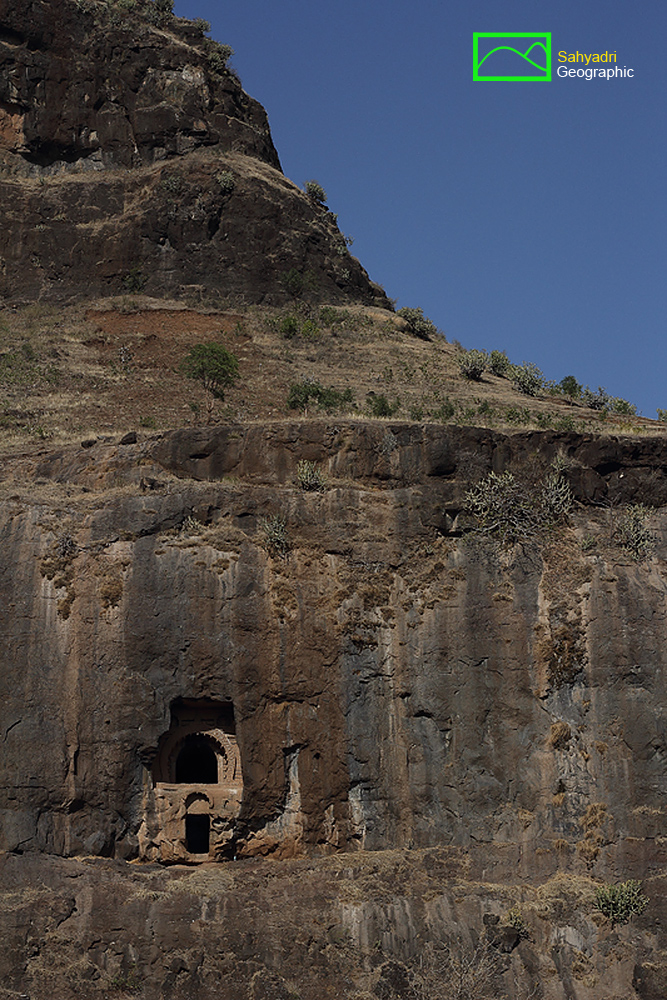 |
| |
| The entrance of the main Chaitya Temple of the forgotten cave temple on the cliff, Junnar, Western ghats, India
|
| |
|
|
Some rock cut caves north of Junaar are located in spur of Sulaiman hill or Ganesh hill. The caves are located about 120 meter above level of Junnar town and 800 meter above msl. The caves face South west direction. The caves are located on precipitous cliff and require climbing knowledge.
|
|
जुन्नर च्या उत्तरेस सुलेमान डोंगराच्या पुर्व बाजुस लेणी आहेत. लेणी डोंगराच्या नाळे ला लगुन कोरलेली आहेत. या लेण्यांना सुलेमान गट अथवा गणेश पुर्व गट असे म्हणतात. समुद्र्सपाटीपासुन ८०० मीटर उंचीवर बनवलेली लेणी, जुन्नर पासुन अंदाजे ७ किमी अंतरावर व जुन्नरपेक्षा अंदाजे १२० मीटर उंच डोंगराच्या कड़्यावर आहेत.
|
|
|
| |
 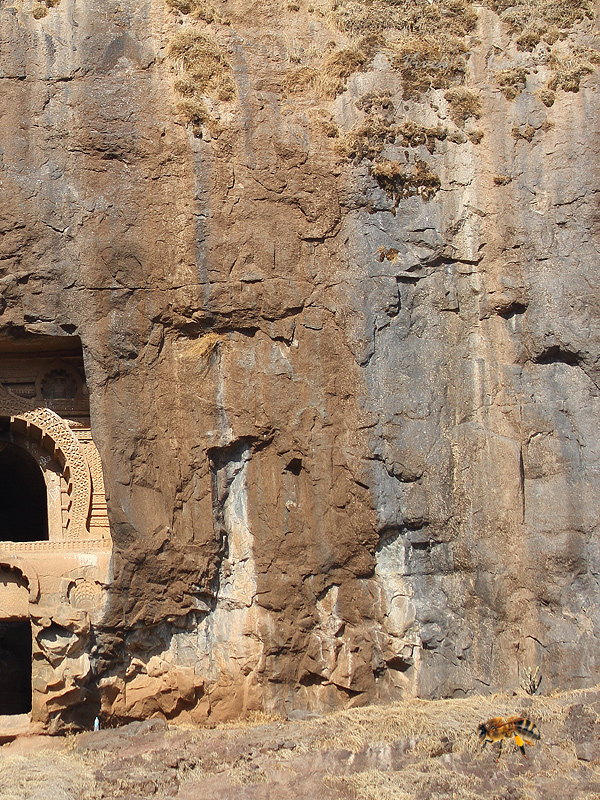
|
| |
| Entrance façade of forgotten cave, Junnar, Western ghats, Maharashtra, India
|
| |
|
|
The real challenge in visiting these caves is the possible attack by honeybees.
The caves here are in wilderness and are not visited by the tourists. The roof of the caves here are adorned by the honey bee hives. Hence visiting these caves is extremely risky as these caves are in wilderness on the cliff full of honeybee hives. There have been fatal honey bee attacks in the caves around Junnar including these caves.
|
|
या लेण्यांमध्ये आग्या मधमाश्यांची पोळी आहेत. यामुळे येथे जाणे अत्यंत धोकादायक आहे. गावापासुन दुर दुर्गम ठिकाणी असलेल्या या लेण्यांमध्ये व अशा जुन्नर जवळच्या इतर लेण्यांमध्ये मधमाश्या चावल्यामुळे अपघात व मृत्यु झाल्याच्या बऱ्याच घटना घडल्या आहेत. स्थानिक वाटाड़्या, व मधमाश्यांपासुन बचाव करता येईल असा बंदिस्त वेश (पुर्ण बंदिस्त जाळीदार टोपीसहित) असल्याशिवाय येथे जाणे टाळावे.
|
|
|
| |
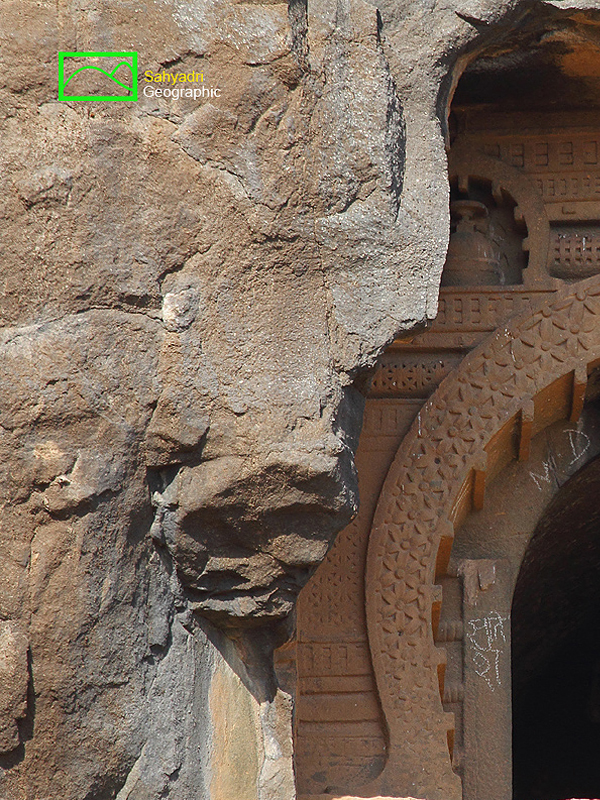 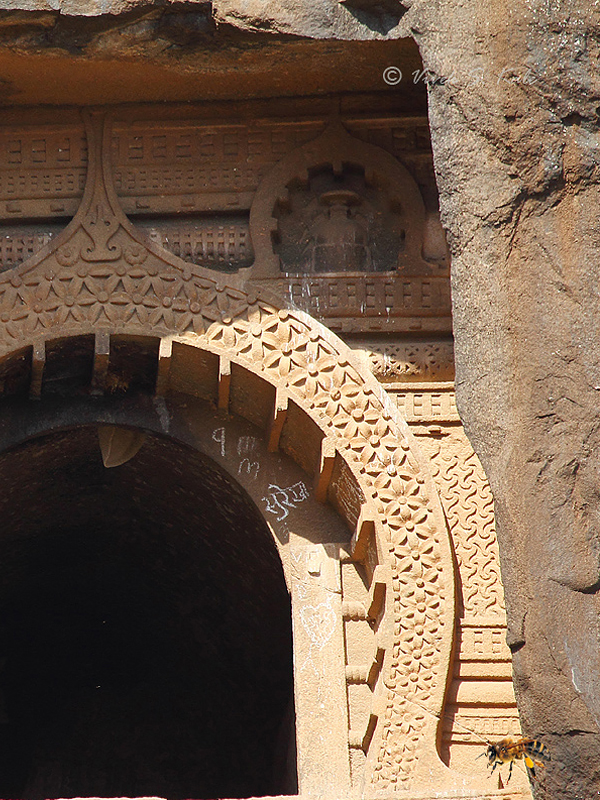 |
| |
| Top window on the entrance façade of forgotten cave, Junnar, Western ghats, Maharashtra, India
|
| |
|
|
On the eastern most end there is a small chaitya cave. The chaitya cave is unfinished.
The magnificence of the chaityaa hall lies in its façade, at the entrance. A façade means the exterior of the building. It is a French word meaning face or frontage.
The façade is highly ornamented and is one of the best cave facades in the region.
The front façade has a beautiful flower carving ornamented on the lattice window. Above which there are 2 carved lattice chaitya window ornaments, enclosing the Stupas. The left one is small and right one is larger stupa. Both the Stupas carved in Chaitya window ornaments are having a capital and carved umbrellas. The carved umbrellas on these small stupas are in good condition.
|
|
चैत्यगृहाच्या समोर दगडी पडदा आहे. व आघाडीला आगाशी (व्हरांडा) आहे. बेडसे येथील चैत्यगृहास दगडी पडदा व आगाशी आहे. सुलेमान लेण्याच्या चैत्यगृहाच्या बाहेरील आगाशी लहान आहे. दगडी पडदयाच्या खालच्या भागात लहान प्रवेशद्वार असुन वर गवाक्ष आहे. गवाक्षाचा आकार पिंपळाच्या अर्धपानासारखा असुन त्याच्या भोवती अत्यंत सुंदर कोरिव नक्षीकाम आहे. जुन्नर भागातील लेण्यांमध्ये हे नक्षीकाम सर्वात सुंदर आहे. गवाक्ष्याच्या दोन्ही बाजुस पिंपळपान कोंदण कोरले आहेत. या कमानींमध्ये स्तुप कोरलेले आहेत. स्तुपांवर हर्मिका व छत्र कोरले आहे. दोन्ही स्तुपांचा आकार वेगवेगळा आहे.
|
|
|
| |
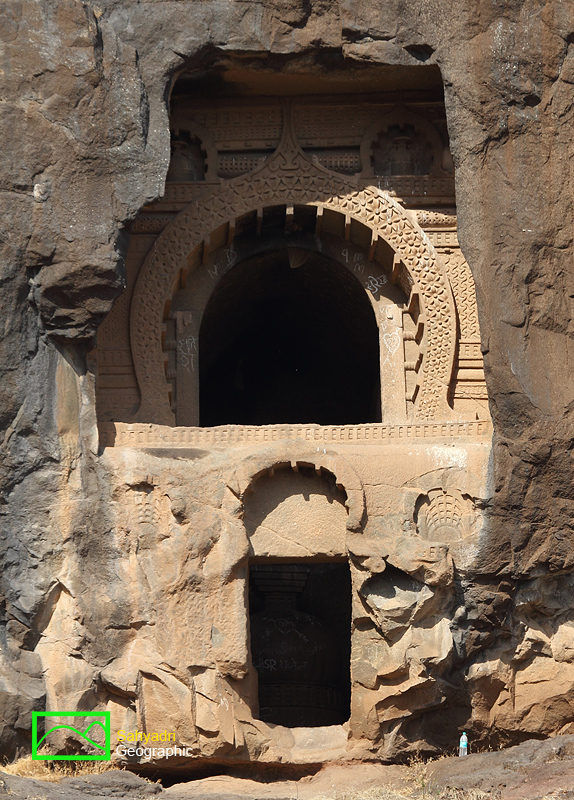 |
| |
| Entrance of forgotten cave, Pune district, Western ghats, India
|
| |
|
|
| |
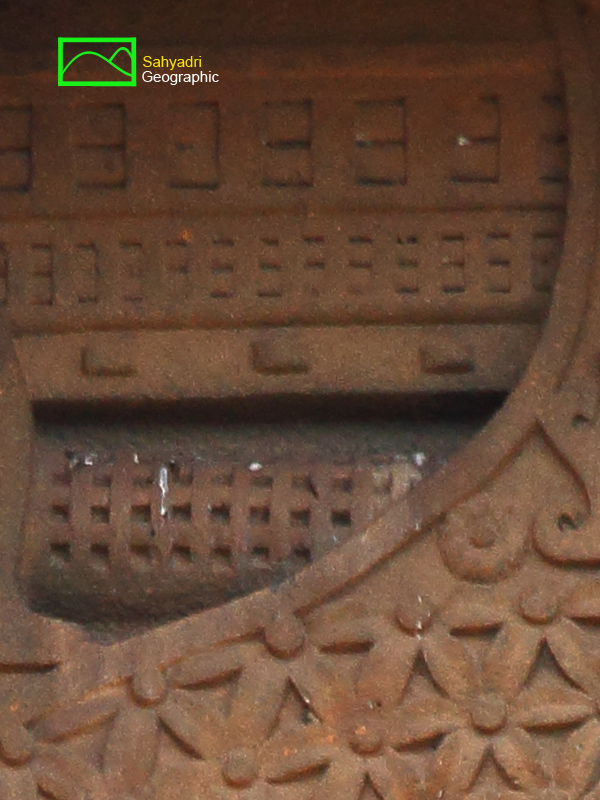 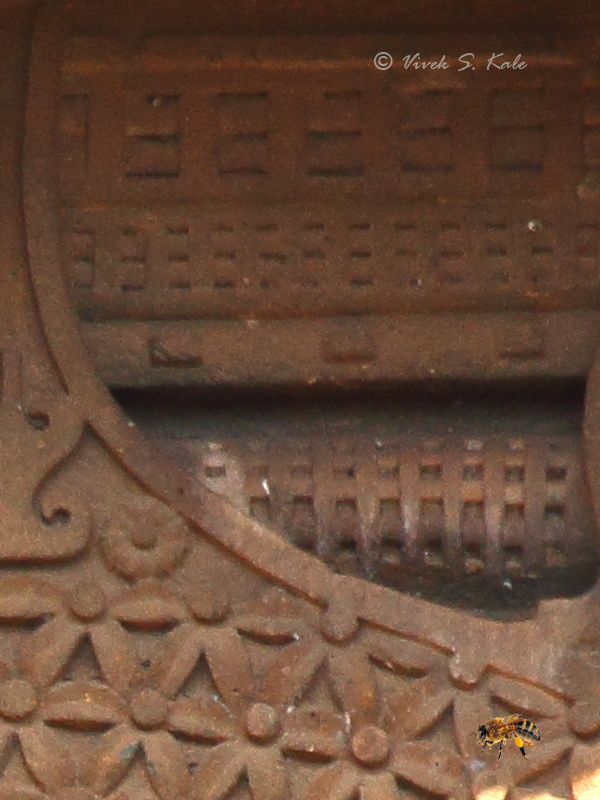 |
| |
| The symbols on entrance facade, Junnar, western ghats, India |
| |
|
|
There are intricate patterns of flat rails, semicylindrical rails on the façade. The surface has patterns which are different on left and on right. On the top there are symbols of srivatsa and two lotus flowers on either side. The flat surface on either sides of façade are also having ornamental patterns. Though some of the rail patterns on front façade are misaligned, this is undoubtedly one of the best ornamental façade of Junnar region. The arch above the main entry door is blind.
|
|
मुख्य़ गवाक्षावर श्रीवत्स व दोन कमळफुले कोरलेली आहेत.दगडी पडद्यावर विविध प्रकारचे नक्षीकाम आहे.
|
|
|
| |
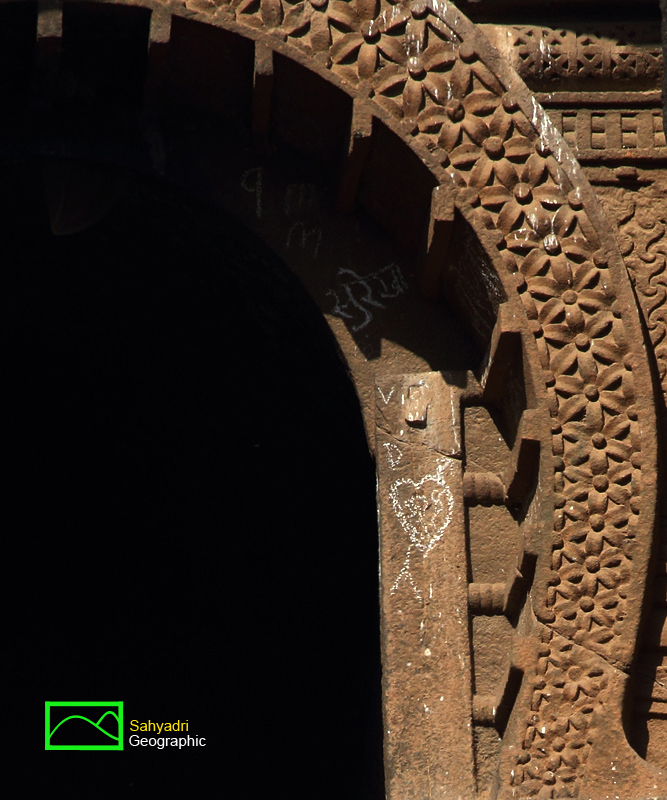
|
| |
| Ornamental carving at the entrance facade of forgotten cave, Pune district, western ghats, India
|
| |
|
|
| |
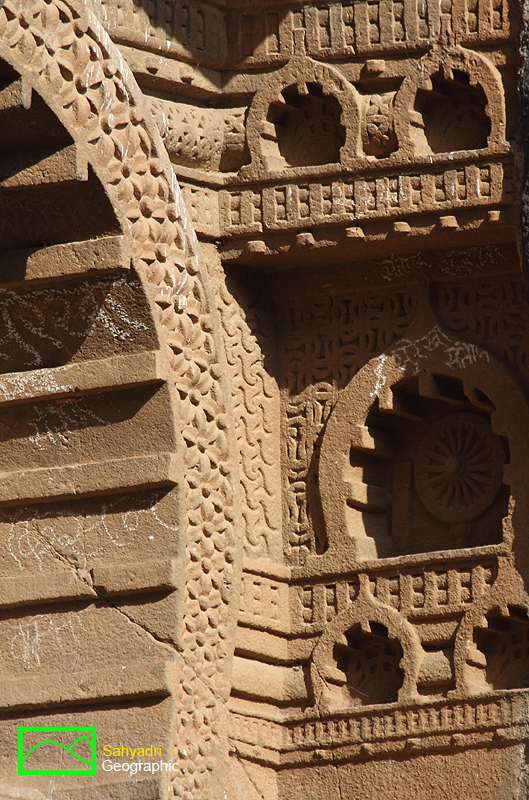
|
| |
| Ornamental carving on the north facing sidewall at the entrance of main chaitya of forgotten cave, western ghats, India |
| |
|
|
On the either side of front facade there are carvings on the side walls of verandah. The north facing façade has also the four carved window ornaments. The top carved window ornament has Stupaa enclosed in it. The missle two smaller window ornaments enclose the carving patterns. The lower carved window ornament has a ornamental Chakra with 16 spokes with small semispheres along the inner circumference. The Chakra is supported on a engraved cylinder at the bottom.
|
|
आगाशीच्या डाव्या व उजव्या भिंतींवर सुद्धा सुंदर कोरिव काम आहे. उत्तरमुखी भिंतीवर ४ पिंपळपान कोंदण कोरलेले आहेत. यात वरच्या कोंदणात स्तुप कोरला आहे. खालच्या कोंदणात धर्मचक्र कोरलेला आहे. मधे २ लहान कोंदण आहेत.
|
|
|
| |

|
| |
| Ornamental carving on the north facing sidewall at the entrance of main chaitya of forgotten cave, western ghats, India
|
| |
|
|
| |
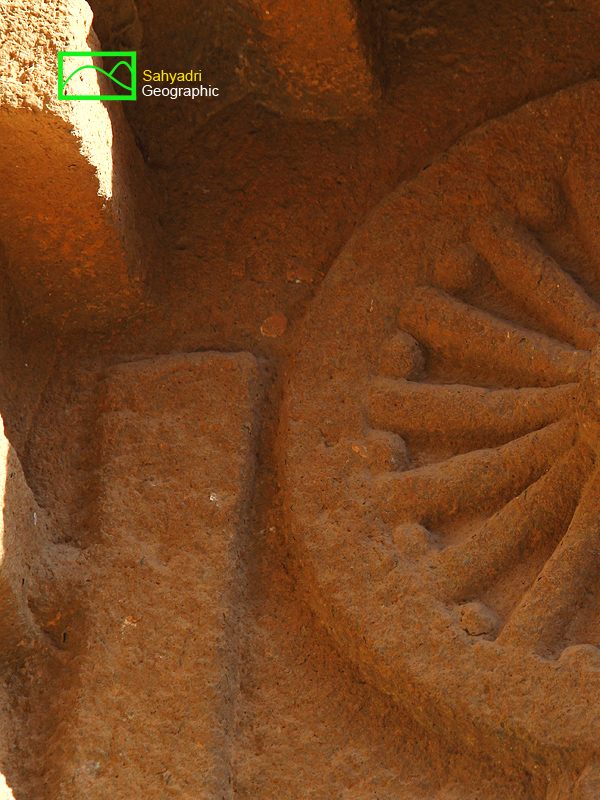 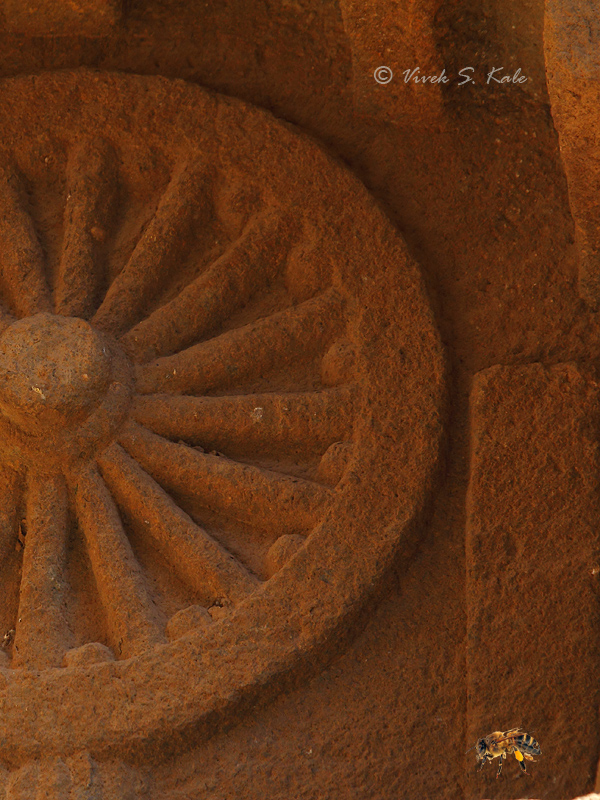 |
| |
| Dharmachakra carving on the north facing sidewall at the entrance of main chaitya of forgotten cave, western ghats, India
|
| |
|
|
| |
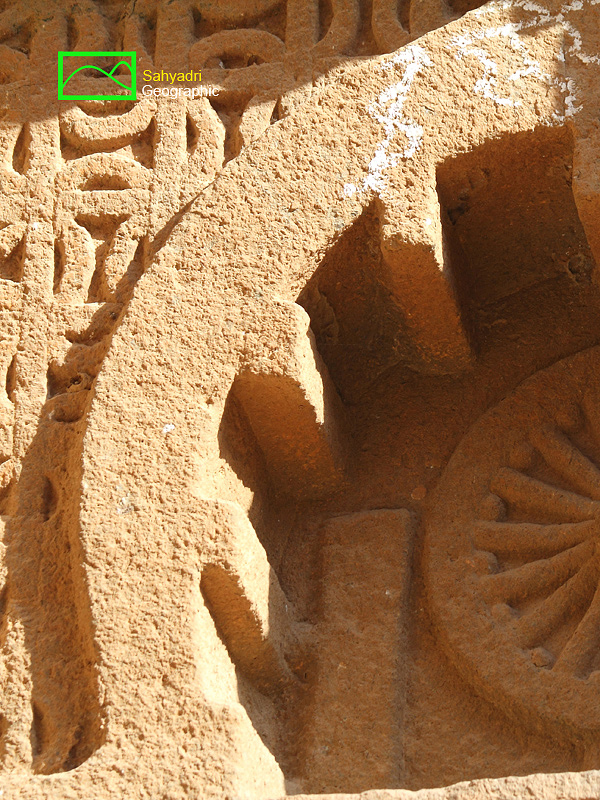  |
| |
| Dharmachakra carving on the north facing sidewall at the entrance of main chaitya of forgotten cave, western ghats, India
|
| |
|
|
| |
 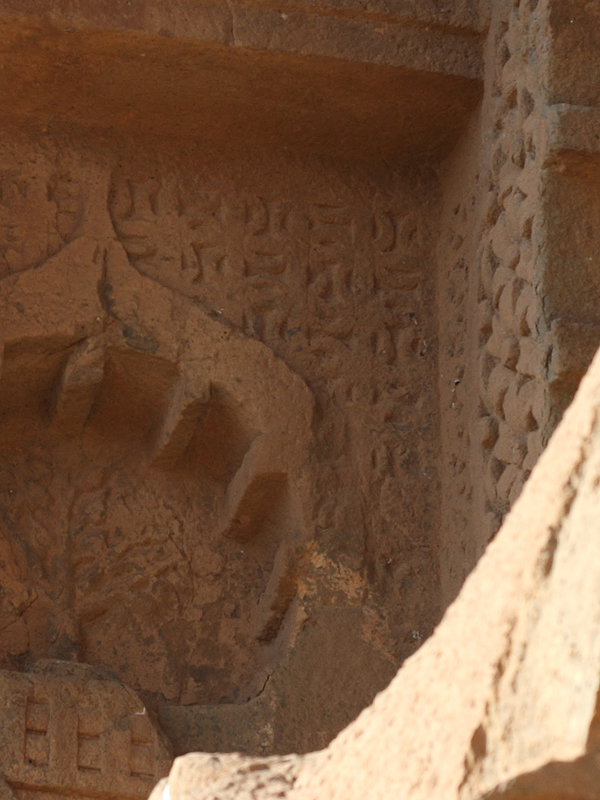
|
| |
| The Bodhi tree symbol, side wall carving, at the main chaitya griha entrance, western ghats, Maharashtra, India
|
| |
|
|
The south facing façade has four carved window ornaments. The top carved window ornament has Stupaa enclosed in it. The middle two smaller window ornaments enclose carving patterns. The lower carved window ornament has a bodhi tree carved in it.
|
|
दक्षिणमुखी भिंतीवर ४ पिंपळपान कोंदण कोरलेले आहेत. यात वरच्या कोंदणात स्तुप कोरला आहे. खालच्या कोंदणात बोधी वृक्ष कोरलेला आहे. मधे २ लहान कोंदण आहेत.
|
|
|
| |
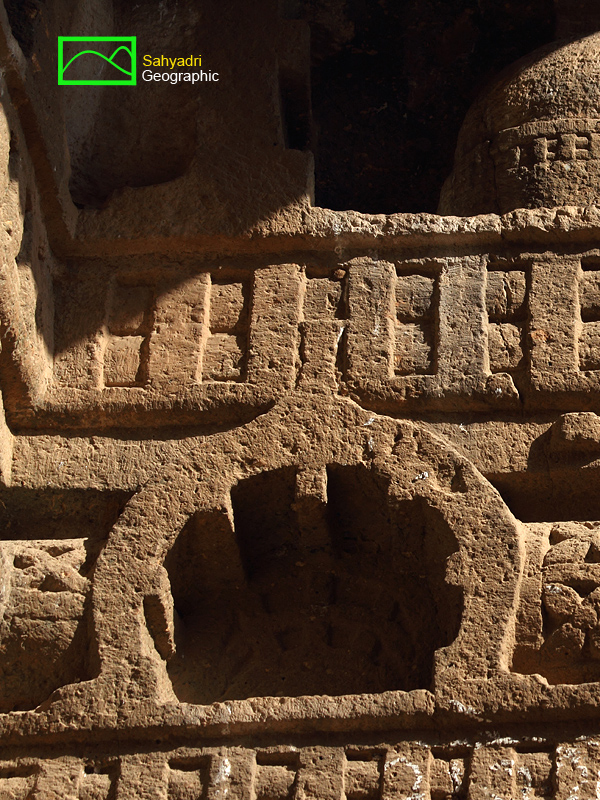 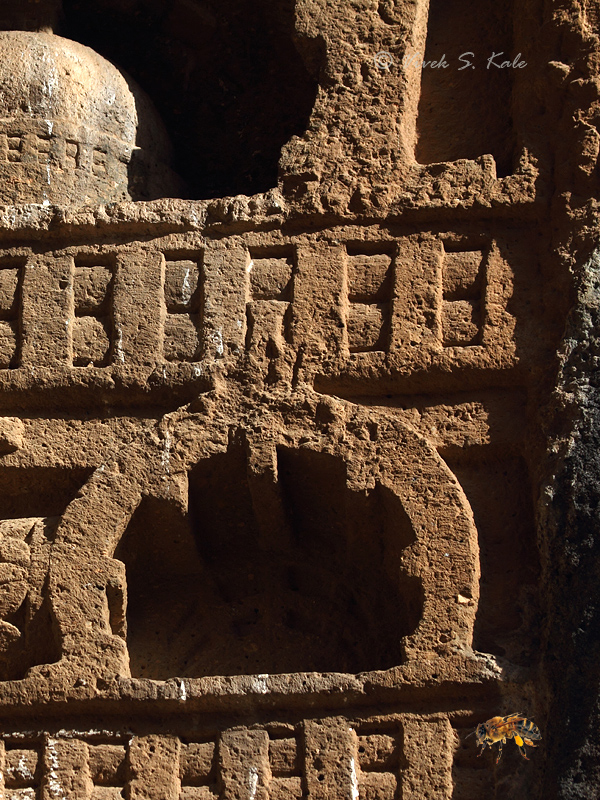
|
| |
| The ornamental carving
|
| |
|
|
| |
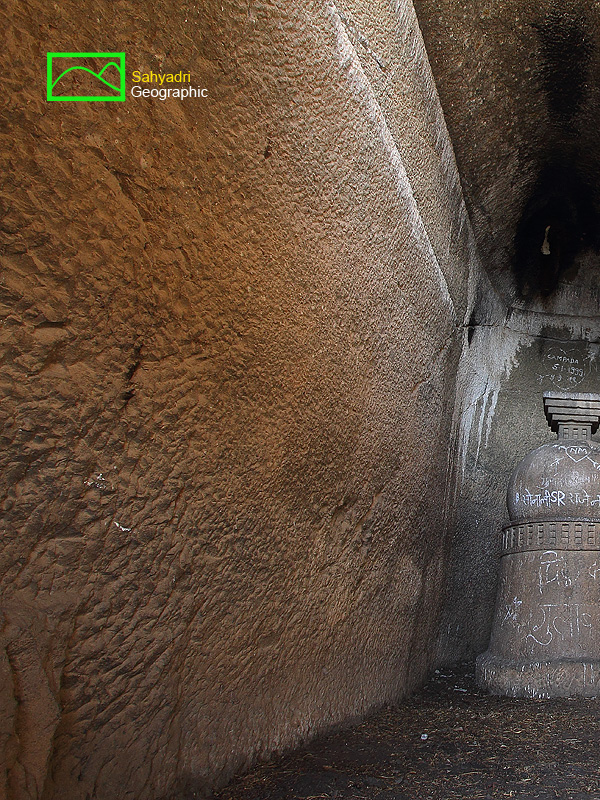 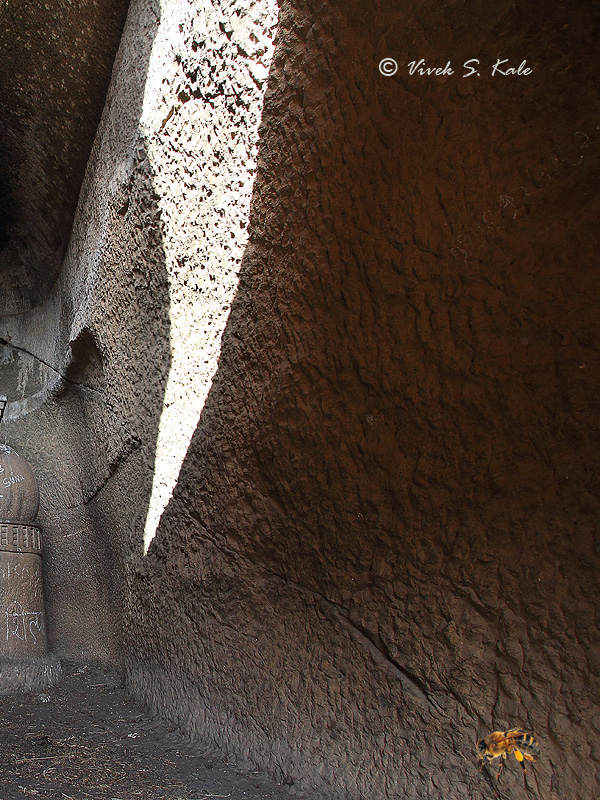 |
| |
| The main chaitya Griha, forgotten cave, western ghats, Maharashtra, India
|
| |
|
|
The cave is about 2.51 meter wide, 6.8 meter in length. The distance between the door and stupaa is 4.7 meter. The stupaa is 1.47 meter in diameter and is 2.85 meter in height. The floor is not flat, and is full of honeybee hive fallouts. The walls are not straight and are little inclined. The height of the hall at the center, is about 5.53 meter.
The stupaa has rail ornamental carving and the capital. The lower part of the stupaa near the floor is in incomplete form. The rear and the south side wall of the chaityaa has a diagonal crack in the rock. This may explain the incompleteness of the Chaitya hall. Next to this main chaityaa hall, there are 2 in accessible caves, a well, a small vihara, with three cells, two of them with stone-beds. Some rough cutting on the back wall between the cell-doors resembles a stupa in low relief, but it is quite unfinished. Outside are two more cells and 8 chamber or chapel at the end of a verandah that runs along in front both of the vihara and the cells. There is a single cave in the precipitous facing these main caves.
|
|
पुर्वेकडे लहान चैत्यविहार आहे. या चैत्यविहाराचे काम अर्धवट सोडलेले आहे. चैत्यविहारात एक स्तुप असुन येथे खांब नाहीत. विहाराची रुंदी २.५ मीटर, लांबी ६.८ मीटर व उंची ५.५३ मीटर आहे. १.४७ मीटर व्यासाचा स्तुप २.८५ मीटर उंच आहे. स्तुपावर हर्मिका आहे. त्यावर छत्र नाही. स्तुपाचा वरचा भाग अंडाकार आहे. अंडाकार अर्धवर्तुळापेक्षा अधिक झालेला आहे. यावरुन हे लेणे अंदाजे इसविसन नंतर दुसऱ्या शतकातले असावे असा अंदाज आहे. चैत्यगृहातील जमिनीवरची पातळी सपाट नसुन ती वरखाली आहे. तसेच मधमाशांच्या पोळ्यांमधील मध व मेणामुळे ती स्वच्छ नाही. चैत्यगृहाच्या आत खांब नसुन भिंती सरळ नाहित. स्तुपावर पट्टि कोरिव काम आहे, मात्र स्तुपाच्या पायाचे काम अर्धवट आहे. स्तुपाच्या दक्षिणेकडे व मागे असलेल्या भिंतींवर दगडात भेग आहे. या भेगेमुळे काम अर्धवट सोडले असावे.
मुख्य चैत्यगृहाच्या उत्तरेस २ लेणी, १ विहार, १ पाण्याचे टाके आहे. या व्यतिरिक्त समोरच्या डोंगरावर एक लेणी आहे. येथील बहुतांश लेणी नैऋत्यमुखी आहेत. लेण्यांच्या या समुहात ७ विहार, १ पाण्याचे टाके, १ चैत्यविहार आहे. येथे शिलालेख नाही.
|
|
|
| |
|
Contact me at kale_v@rediffmail.com for any queries and asuggestions.
| |